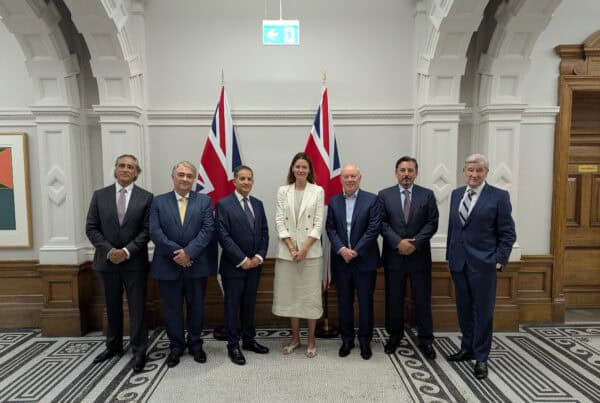
Thames Freeport is a leading player in the global trade objectives for the UK and an extremely beneficial destination for overseas companies to grow the international side of their business. Freeports across the UK assist the country in global trade and facilitate new businesses expanding into the United Kingdom.
With its location close to the nation’s capital, Thames Freeport is one of the most strategically important special economic zones in the UK. How Thames Freeport facilitates global trade is due to boasting the best international connections, Thames Freeport is a leading tax zone in the country with the ability to facilitate global trade. Connected to 65 countries through more than 130 ports, Thames Freeport is an incredible conductor of international trade. Boasting excellent onward connections by air, river, rail and road, Thames Freeport is highly attractive to international businesses as a top destination for import and export. While still a rising star, Thames Freeport has levelled up the global trade opportunities for the UK with global shipping routes to destinations across the world and the platform to expand international businesses.
Is the River Thames Used for Trade?
As the second-largest river in the UK and the iconic waterway flowing through the British capital, the River Thames is one of the premier trade points in the UK. The entire stretch of the river is actively used for trade, with the Thames having a long and rich history as a key commercial waterway. With access to both national and international markets, the river plays a vital role in logistics, imports and exports.
The River Thames has an incredible number of ports with the Port of London, Port of Tilbury and London Gateway being the largest commercial ports in the city. Plus, the River Thames is home to Ford Dagenham, London’s largest manufacturing location with its own port.
Port of London
Covering 95 miles of the River Thames, the Port of London is home to over 70 independently owned terminals and has played a major role in the country’s trade for centuries by connecting London with the rest of the world.
Port of Tilbury
The largest of the Thames ports, Tilbury is London’s major port, handling 16 million tonnes of cargo per year.
London Gateway
Operated by DP World, London Gateway is the UK’s largest logistics hub, connected to over 130 ports and 65 countries with the ability to handle the world’s largest vessels.
Ford Dagenham
As London’s largest manufacturing location for over 90 years, the Ford Dagenham Engine Plant is a tax site within the Thames Freeport that provides great proximity to suppliers and access to regional manufacturing clusters.
Both the Port of Tilbury and London Gateway, as well as Ford Dagenham, are partners of Thames Freeport, a trade zone that further boosts trade activities on the river. Nestled on the banks of the River Thames, Thames Freeport is a central hub for trade in the UK. Located close to the capital, Thames Freeport has exceptional connections by road, rail, river and air that extend not only across the country but internationally. With Europe’s largest consumer market on its doorstep, Thames Freeport is in a prime position for business. Connected to over 65 countries across the globe via more than 130 ports, Thames Freeport is a strategic connector of global trade.
How Does Thames Freeport Facilitate Global Trade?
Thames Freeport facilitates global trade by offering both national and international businesses incentives and strategic advantages to build and grow at this tax site.
The Location of Thames Freeport is Important for Global Trade
Located along the Thames, the Freeport has direct access to global shipping routes via the Port of Tilbury and DP World London Gateway, enabling efficient import and export activities. Its location also boasts easy access to London’s three major airports, Heathrow, Gatwick and London City for importation and exportation by air. In addition, the south has international rail connections with train services from St Pancras International to destinations across Europe. It is the most well-connected Freeport in the country with direct access to international hubs across the world by rail, air, water and road. This is a major advantage to global trade, allowing international businesses to expand not only across the length of the UK but also across Europe and into other continents.
Access to Europe’s Largest Consumer Market
As the capital of the UK and one of Europe’s leading cities, London is home to the largest economically active consumer markets on the continent. With 18 million consumers located on the doorstep of Thames Freeport, it has never been easier for international businesses to get their products in front of a huge customer base. This is hugely attractive to overseas businesses and is one of the greatest benefits for international companies looking to expand into the UK. In addition to having the consumers of London easily accessible, the excellent connections close to Thames Freeport by rail, road and air facilities onward travel for goods to the rest of the UK and into the wider European market.
Benefits of Thames Freeport Facilitates Global Trade
Thames Freeport provides customs benefits like duty deferral and duty exemption on goods that are imported and re-exported. Relaxed customs arrangements streamline processes, making it easier for businesses to move goods and trade across the world. Additionally, the financial incentives offered by Thames Freeport like tax reliefs and reduced business rates attract and incentivise international trade to expand into the UK. Whether companies are building, expanding or relocating, the benefits of Thames Freeport help businesses to thrive.
It’s Cost-effective to Trade Globally from Thames Freeport
With its excellent connections and range of benefits, global trade is the most cost-effective from Thames Freeport. This makes it easier and cheaper to import and export goods to and from the UK while international businesses will find Thames Freeport to be a tax-efficient destination to expand. With these savings, businesses have enhanced flexibility within their business budget and greater profits.
Low Carbon Footprint at Thames Freeport
While Thames Freeport has excellent surrounding connections by rail, road and air, its value lies in its riverfront location. The ability to trade across the UK via river and across the world by sea is not only more affordable, it is also a great solution to trade globally in a more eco-friendly manner. Thanks to its low-carbon logistics and the ability to trade via the river, Thames Freeport is the answer to one of the biggest global challenges for importing and exporting. Goods can be moved across major waterways, directly from the UK, with a commitment to decarbonisation, attracting partnerships and trade with countries and businesses in search of cost-effective and eco-conscious trading solutions.
Rail Connections
With local rail connections in London not only across the UK but also into Europe, Thames Freeport is close to one of the best-connected cities on the planet. In addition to the British market, products will be placed in front of the European market too with cost-efficient re-exportation by rail.



